Abstract
O-antigen-deficient derivatives of two mouse-virulent strains of Salmonella choleraesuis (serogroup C1; O-6,7) were constructed by transduction of a long deletion of the rfb operon. Strains SN36 and SN57 were derived from the smooth ancestor SL2824, while SN37 was derived from the smooth ancestor SL2840. These rfb deletion derivatives (rfb strains) had typical bacteriophage sensitivity patterns of "rough" Salmonella strains and were at least 200,000 times more sensitive to serum than their smooth ancestors. Lipopolysaccharides (LPS) extracted from them consisted only of two low-molecular-weight bands and lacked the ladderlike pattern of bands seen in the LPS of their smooth ancestors. The LPS from the rfb strains did not react in an enzyme immunoassay with any of three monoclonal antibodies directed against different epitopes of the O-6,7 antigen but reacted well with at least one of three monoclonal antibodies specific for core epitopes. The data were consistent with inability of these strains to synthesize O-specific chains and showed that the LPS extracted from SN57 was of chemotype Ra and that from SN36 was of chemotype Rb1, while that of SN37 consisted of a mixture of the two chemotypes. The virulence of these strains was tested by various routes in BALB/c mice. All three O-antigen-deficient derivatives were about as virulent as their "smooth" ancestors by the intraperitoneal and intravenous routes (50% lethal dose, 20 to 700 bacteria) but, unlike their ancestors, were avirulent by the oral route (50% lethal dose, greater than or equal to 5 x 10(9) bacteria). This suggests that the major role of smooth LPS in the mouse virulence of S. choleraesuis is to facilitate survival in the gastrointestinal tract and eventual entry into deeper tissues.
Full text
PDF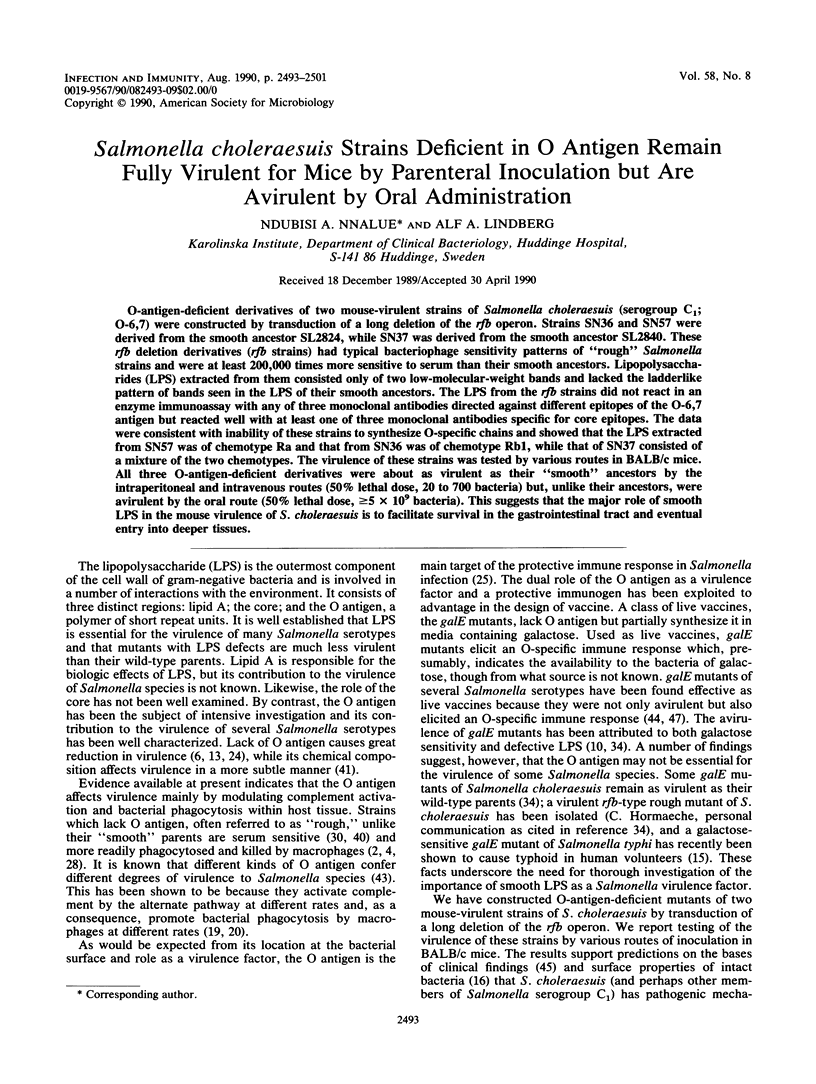

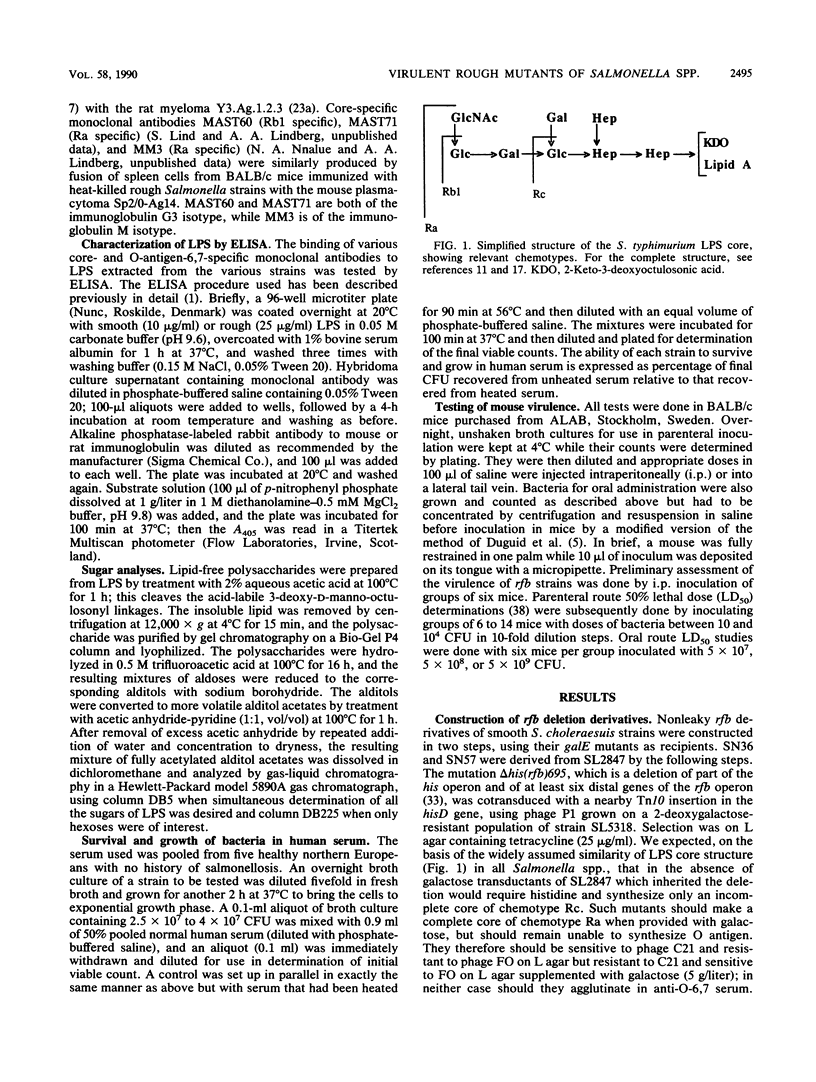
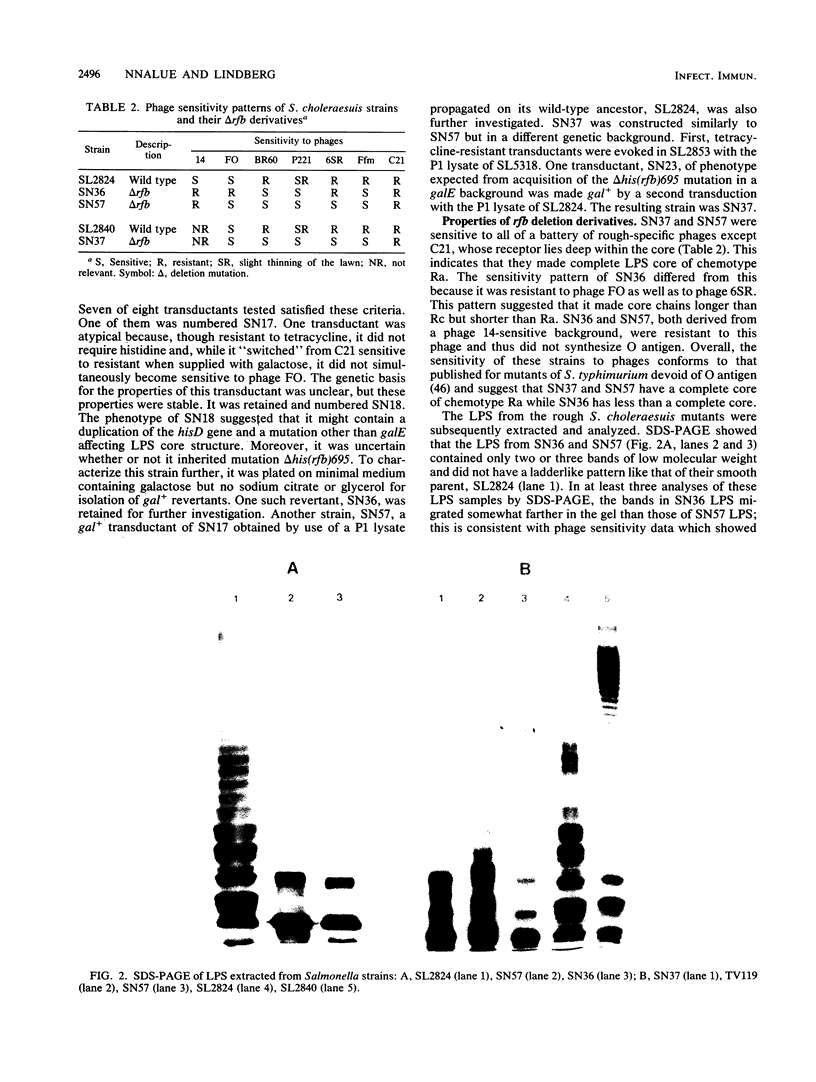
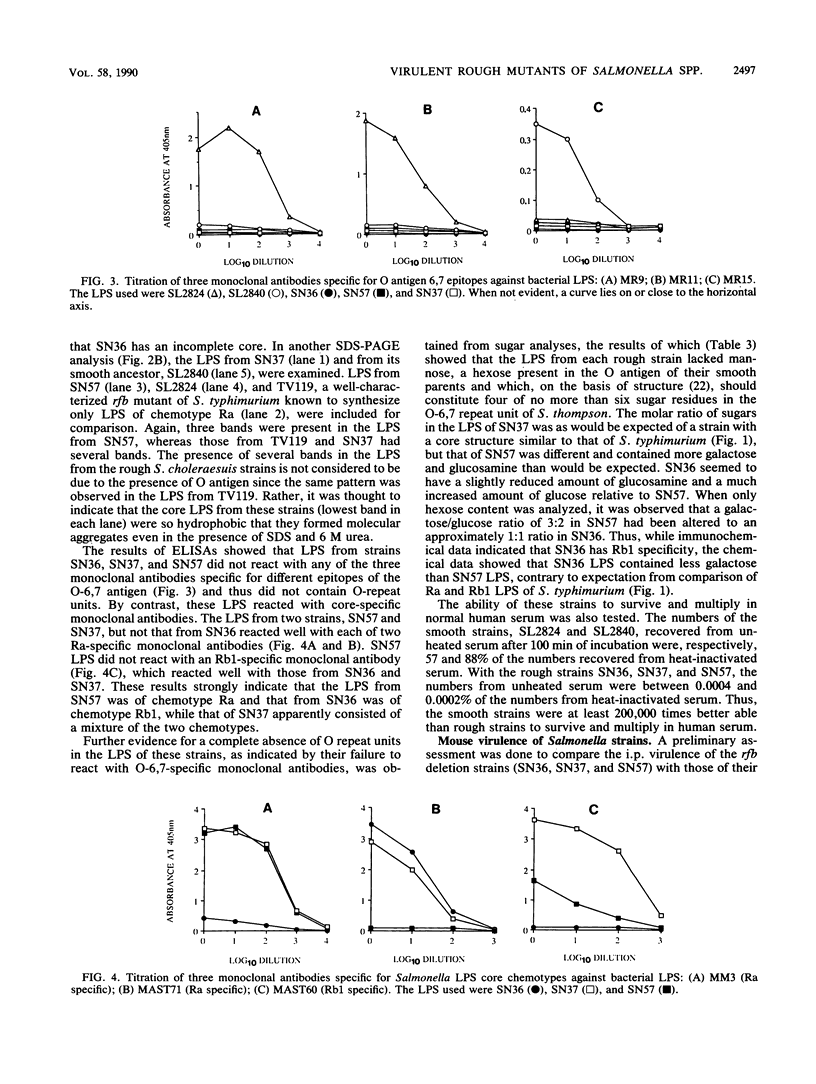
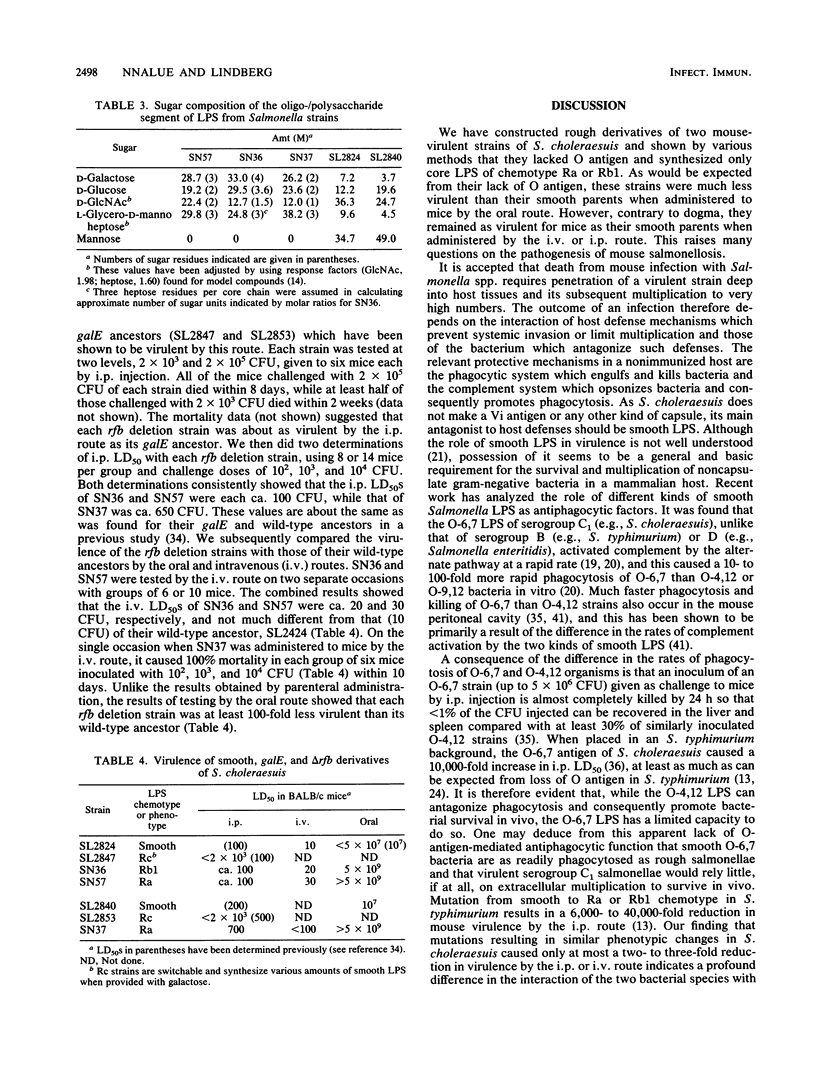
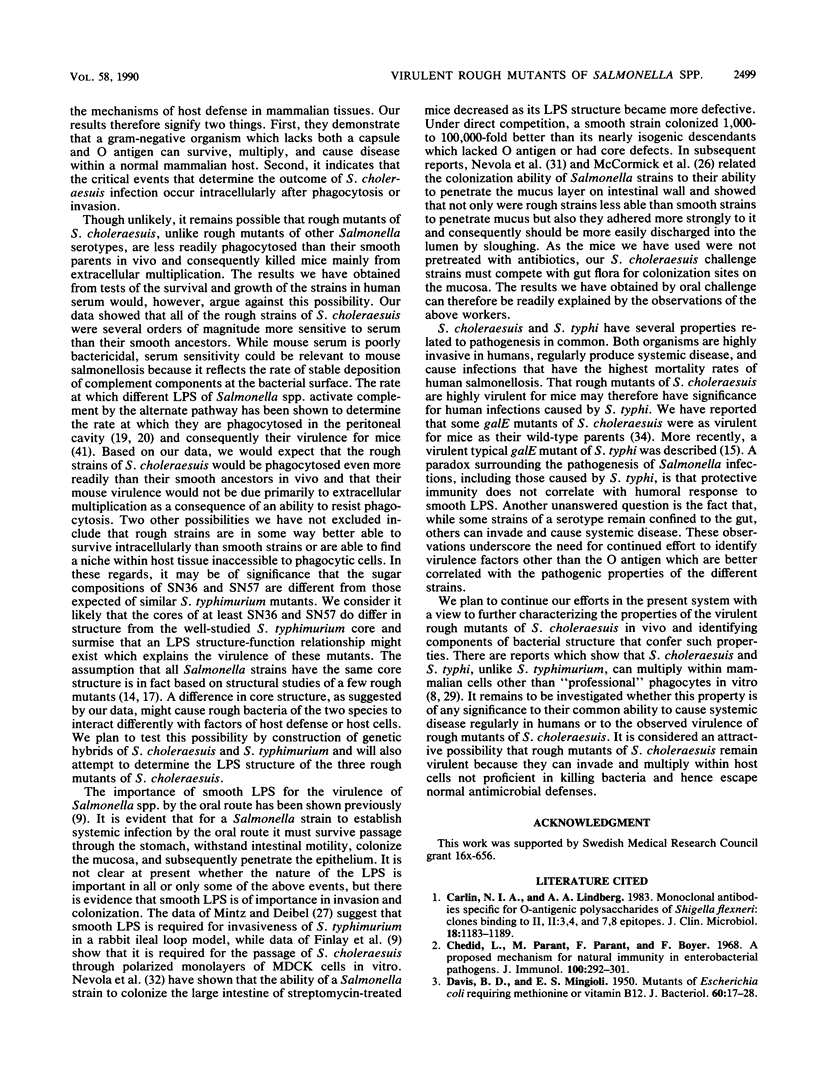


Images in this article
Selected References
These references are in PubMed. This may not be the complete list of references from this article.
- Carlin N. I., Lindberg A. A. Monoclonal antibodies specific for O-antigenic polysaccharides of Shigella flexneri: clones binding to II, II:3,4, and 7,8 epitopes. J Clin Microbiol. 1983 Nov;18(5):1183–1189. doi: 10.1128/jcm.18.5.1183-1189.1983. [DOI] [PMC free article] [PubMed] [Google Scholar]
- Chedid L., Parant M., Parant F., Boyer F. A proposed mechanism for natural immunity to enterobacterial pathogens. J Immunol. 1968 Feb;100(2):292–306. [PubMed] [Google Scholar]
- DAVIS B. D., MINGIOLI E. S. Mutants of Escherichia coli requiring methionine or vitamin B12. J Bacteriol. 1950 Jul;60(1):17–28. doi: 10.1128/jb.60.1.17-28.1950. [DOI] [PMC free article] [PubMed] [Google Scholar]
- Dlabac V. The sensitivity of smooth and rough mutants of Salmonella typhimurium to bactericidal and bacteriolytic action of serum, lysozyme and to phagocytosis. Folia Microbiol (Praha) 1968;13(5):439–449. doi: 10.1007/BF02869196. [DOI] [PubMed] [Google Scholar]
- Duguid J. P., Darekar M. R., Wheater D. W. Fimbriae and infectivity in Salmonella typhimurium. J Med Microbiol. 1976 Nov;9(4):459–473. doi: 10.1099/00222615-9-4-459. [DOI] [PubMed] [Google Scholar]
- Edebo L., Normann B. Virulence and immunogenicity of mutant strains of Salmonella typhimurium. Acta Pathol Microbiol Scand B Microbiol Immunol. 1970;78(1):75–84. doi: 10.1111/j.1699-0463.1970.tb04271.x. [DOI] [PubMed] [Google Scholar]
- Enomoto M., Stocker B. A. Transduction by phage P1kc in Salmonella typhimurium. Virology. 1974 Aug;60(2):503–514. doi: 10.1016/0042-6822(74)90344-4. [DOI] [PubMed] [Google Scholar]
- FUKASAWA T., NIKAIDO H. Galactose-sensitive mutants of Salmonella. II. Bacteriolysis induced by galactose. Biochim Biophys Acta. 1961 Apr 15;48:470–483. doi: 10.1016/0006-3002(61)90045-2. [DOI] [PubMed] [Google Scholar]
- Finlay B. B., Falkow S. Comparison of the invasion strategies used by Salmonella cholerae-suis, Shigella flexneri and Yersinia enterocolitica to enter cultured animal cells: endosome acidification is not required for bacterial invasion or intracellular replication. Biochimie. 1988 Aug;70(8):1089–1099. doi: 10.1016/0300-9084(88)90271-4. [DOI] [PubMed] [Google Scholar]
- Finlay B. B., Starnbach M. N., Francis C. L., Stocker B. A., Chatfield S., Dougan G., Falkow S. Identification and characterization of TnphoA mutants of Salmonella that are unable to pass through a polarized MDCK epithelial cell monolayer. Mol Microbiol. 1988 Nov;2(6):757–766. doi: 10.1111/j.1365-2958.1988.tb00087.x. [DOI] [PubMed] [Google Scholar]
- Galanos C., Lüderitz O., Westphal O. A new method for the extraction of R lipopolysaccharides. Eur J Biochem. 1969 Jun;9(2):245–249. doi: 10.1111/j.1432-1033.1969.tb00601.x. [DOI] [PubMed] [Google Scholar]
- Germanier R. Immunity in Experimental Salmonellosis I. Protection Induced by Rough Mutants of Salmonella typhimurium. Infect Immun. 1970 Sep;2(3):309–315. doi: 10.1128/iai.2.3.309-315.1970. [DOI] [PMC free article] [PubMed] [Google Scholar]
- Hone D. M., Attridge S. R., Forrest B., Morona R., Daniels D., LaBrooy J. T., Bartholomeusz R. C., Shearman D. J., Hackett J. A galE via (Vi antigen-negative) mutant of Salmonella typhi Ty2 retains virulence in humans. Infect Immun. 1988 May;56(5):1326–1333. doi: 10.1128/iai.56.5.1326-1333.1988. [DOI] [PMC free article] [PubMed] [Google Scholar]
- Huixiu J., Stendahl O., Edebo L. Activation of polymorphonuclear leukocytes by salmonella. Acta Pathol Microbiol Immunol Scand B. 1984 Apr;92(2):107–113. doi: 10.1111/j.1699-0463.1984.tb02803.x. [DOI] [PubMed] [Google Scholar]
- Jansson P. E., Lindberg A. A., Lindberg B., Wollin R. Structural studies on the hexose region of the core in lipopolysaccharides from Enterobacteriaceae. Eur J Biochem. 1981 Apr;115(3):571–577. doi: 10.1111/j.1432-1033.1981.tb06241.x. [DOI] [PubMed] [Google Scholar]
- KONDO E., MITSUHASHI S. DRUG RESISTANCE OF ENTERIC BACTERIA. IV. ACTIVE TRANSDUCING BACTERIOPHAGE P1 CM PRODUCED BY THE COMBINATION OF R FACTOR WITH BACTERIOPHAGE P1. J Bacteriol. 1964 Nov;88:1266–1276. doi: 10.1128/jb.88.5.1266-1276.1964. [DOI] [PMC free article] [PubMed] [Google Scholar]
- Liang-Takasaki C. J., Grossman N., Leive L. Salmonellae activate complement differentially via the alternative pathway depending on the structure of their lipopolysaccharide O-antigen. J Immunol. 1983 Apr;130(4):1867–1870. [PubMed] [Google Scholar]
- Liang-Takasaki C. J., Mäkelä P. H., Leive L. Phagocytosis of bacteria by macrophages: changing the carbohydrate of lipopolysaccharide alters interaction with complement and macrophages. J Immunol. 1982 Mar;128(3):1229–1235. [PubMed] [Google Scholar]
- Lindberg A. A. Bacterial virulence factors--with particular reference to Salmonella bacteria. Scand J Infect Dis Suppl. 1980;Suppl 24:86–92. [PubMed] [Google Scholar]
- Lindberg B., Leontein K., Lindquist U., Svenson S. B., Wrangsell G., Dell A., Rogers M. Structural studies of the O-antigen polysaccharide of Salmonella thompson, serogroup C1 (6,7). Carbohydr Res. 1988 Mar 15;174:313–322. doi: 10.1016/0008-6215(88)85100-0. [DOI] [PubMed] [Google Scholar]
- Luk J. M., Nnalue N. A., Lindberg A. A. Efficient production of mouse and rat monoclonal antibodies against the O antigens of Salmonella serogroup C1, using LPS-coated bacteria as immunogen. J Immunol Methods. 1990 May 25;129(2):243–250. doi: 10.1016/0022-1759(90)90445-2. [DOI] [PubMed] [Google Scholar]
- Lyman M. B., Steward J. P., Roantree R. J. Characterization of the virulence and antigenic structure of Salmonella typhimurium strains with lipopolysaccharide core defects. Infect Immun. 1976 Jun;13(6):1539–1542. doi: 10.1128/iai.13.6.1539-1542.1976. [DOI] [PMC free article] [PubMed] [Google Scholar]
- Lyman M. B., Stocker B. A., Roantree R. J. Evaluation of the immune response directed against the Salmonella antigenic factors O4,5 and O9. Infect Immun. 1979 Dec;26(3):956–965. doi: 10.1128/iai.26.3.956-965.1979. [DOI] [PMC free article] [PubMed] [Google Scholar]
- MITSUHASHI S., SATO I., TANAKA T. Experimental salmonellosis. Intracellular growth of Salmonella enteritidis ingested in mononuclear phagocytes of mice, and cellular basis of immunity. J Bacteriol. 1961 Jun;81:863–868. doi: 10.1128/jb.81.6.863-868.1961. [DOI] [PMC free article] [PubMed] [Google Scholar]
- McCormick B. A., Stocker B. A., Laux D. C., Cohen P. S. Roles of motility, chemotaxis, and penetration through and growth in intestinal mucus in the ability of an avirulent strain of Salmonella typhimurium to colonize the large intestine of streptomycin-treated mice. Infect Immun. 1988 Sep;56(9):2209–2217. doi: 10.1128/iai.56.9.2209-2217.1988. [DOI] [PMC free article] [PubMed] [Google Scholar]
- Mintz C. S., Deibel R. H. Effect of lipopolysaccharide mutations on the pathogenesis of experimental Salmonella gastroenteritis. Infect Immun. 1983 Apr;40(1):236–244. doi: 10.1128/iai.40.1.236-244.1983. [DOI] [PMC free article] [PubMed] [Google Scholar]
- Mroczenski-Wildey M. J., Di Fabio J. L., Cabello F. C. Invasion and lysis of HeLa cell monolayers by Salmonella typhi: the role of lipopolysaccharide. Microb Pathog. 1989 Feb;6(2):143–152. doi: 10.1016/0882-4010(89)90017-x. [DOI] [PubMed] [Google Scholar]
- Nelson B. W., Roantree R. J. Analyses of lipopolysaccharides extracted from penicillin-resistant, serum-sensitive salmonella mutants. J Gen Microbiol. 1967 Aug;48(2):179–188. doi: 10.1099/00221287-48-2-179. [DOI] [PubMed] [Google Scholar]
- Nevola J. J., Laux D. C., Cohen P. S. In vivo colonization of the mouse large intestine and in vitro penetration of intestinal mucus by an avirulent smooth strain of Salmonella typhimurium and its lipopolysaccharide-deficient mutant. Infect Immun. 1987 Dec;55(12):2884–2890. doi: 10.1128/iai.55.12.2884-2890.1987. [DOI] [PMC free article] [PubMed] [Google Scholar]
- Nevola J. J., Stocker B. A., Laux D. C., Cohen P. S. Colonization of the mouse intestine by an avirulent Salmonella typhimurium strain and its lipopolysaccharide-defective mutants. Infect Immun. 1985 Oct;50(1):152–159. doi: 10.1128/iai.50.1.152-159.1985. [DOI] [PMC free article] [PubMed] [Google Scholar]
- Nikaido H., Levinthal M., Nikaido K., Nakane K. Extended deletions in the histidine-rough-B region of the Salmonella chromosome. Proc Natl Acad Sci U S A. 1967 Jun;57(6):1825–1832. doi: 10.1073/pnas.57.6.1825. [DOI] [PMC free article] [PubMed] [Google Scholar]
- Nnalue N. A., Stocker B. A. Some galE mutants of Salmonella choleraesuis retain virulence. Infect Immun. 1986 Dec;54(3):635–640. doi: 10.1128/iai.54.3.635-640.1986. [DOI] [PMC free article] [PubMed] [Google Scholar]
- Nnalue N. A., Stocker B. A. Test of the virulence and live-vaccine efficacy of auxotrophic and galE derivatives of Salmonella choleraesuis. Infect Immun. 1987 Apr;55(4):955–962. doi: 10.1128/iai.55.4.955-962.1987. [DOI] [PMC free article] [PubMed] [Google Scholar]
- Nnalue N. A., Stocker B. A. The effects of O-antigen character and enterobacterial common antigen content on the in vivo persistence of aromatic-dependent Salmonella sp. live-vaccine strains. Microb Pathog. 1987 Jul;3(1):31–44. doi: 10.1016/0882-4010(87)90035-0. [DOI] [PubMed] [Google Scholar]
- Ornellas E. P., Stocker B. A. Relation of lipopolysaccharide character to P1 sensitivity in Salmonella typhimurium. Virology. 1974 Aug;60(2):491–502. doi: 10.1016/0042-6822(74)90343-2. [DOI] [PubMed] [Google Scholar]
- Rosner J. L. Formation, induction, and curing of bacteriophage P1 lysogens. Virology. 1972 Jun;48(3):679–689. doi: 10.1016/0042-6822(72)90152-3. [DOI] [PubMed] [Google Scholar]
- Saxén H., Reima I., Mäkelä P. H. Alternative complement pathway activation by Salmonella O polysaccharide as a virulence determinant in the mouse. Microb Pathog. 1987 Jan;2(1):15–28. doi: 10.1016/0882-4010(87)90111-2. [DOI] [PubMed] [Google Scholar]
- Tsai C. M., Frasch C. E. A sensitive silver stain for detecting lipopolysaccharides in polyacrylamide gels. Anal Biochem. 1982 Jan 1;119(1):115–119. doi: 10.1016/0003-2697(82)90673-x. [DOI] [PubMed] [Google Scholar]
- Valtonen M. V., Plosila M., Valtonen V. V., Mäkelä P. H. Effect of the quality of the lipopolysaccharide on mouse virulence of Salmonella enteritidis. Infect Immun. 1975 Oct;12(4):828–832. doi: 10.1128/iai.12.4.828-832.1975. [DOI] [PMC free article] [PubMed] [Google Scholar]
- Wahdan M. H., Sérié C., Cerisier Y., Sallam S., Germanier R. A controlled field trial of live Salmonella typhi strain Ty 21a oral vaccine against typhoid: three-year results. J Infect Dis. 1982 Mar;145(3):292–295. doi: 10.1093/infdis/145.3.292. [DOI] [PubMed] [Google Scholar]
- Weissbluth M., Shulman S. T., Holson B., Lerner C. Salmonella cholera-suis: a distinctive bacterial pathogen. J Pediatr. 1981 Mar;98(3):423–426. doi: 10.1016/s0022-3476(81)80710-x. [DOI] [PubMed] [Google Scholar]
- Wilkinson R. G., Gemski P., Jr, Stocker B. A. Non-smooth mutants of Salmonella typhimurium: differentiation by phage sensitivity and genetic mapping. J Gen Microbiol. 1972 May;70(3):527–554. doi: 10.1099/00221287-70-3-527. [DOI] [PubMed] [Google Scholar]
- Wray C., Sojka W. J., Morris J. A., Brinley Morgan W. J. The immunization of mice and calves with gal E mutants of Salmonella typhimurium. J Hyg (Lond) 1977 Aug;79(1):17–24. doi: 10.1017/s0022172400052803. [DOI] [PMC free article] [PubMed] [Google Scholar]



